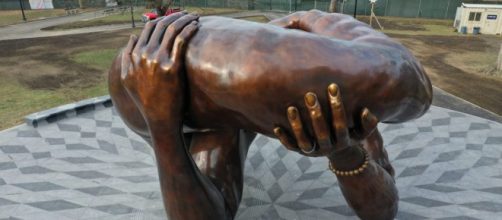Statues of bodiless heads have their place in art history. The bust of Nefertiti, an Egyptian pharaoh’s wife, is one of many examples.
But statues of dismembered limbs are not common. The closest example that comes to mind is the evocative 24-foot-long bronze fist memorializing the boxing champ Joe Louis in downtown Detroit.
Now comes another fractured bronze memorial, this time of two arms in an embrace honoring Martin Luther King Jr. and his wife Coretta Schott King.
But this time the statue comes across as creepy.
The artist, Han Willis Thomas, who trained in photography, based his image on a photograph of King and his wife hugging after winning the Nobel Peace Prize.
What is it
But that’s not necessarily what you see in the statue titled “The Embrace.” As news stories make plain, you don’t see hugging arms from all angles.
This is a case of an artist focused on a photograph rather than envisioning his subject in the round with more than one side on view. The arms get lost in the translation from two dimensions to three.
So, when the statue was unveiled last week on Boston Commons where King famously spoke to 22,000 people in 1965, CNN reported a public “backlash.”
The outsized scale of the arms beyond human proportion – at 20 feet tall and 26 feet wide – also opened them to other interpretations, including what some have seen as pornographic. This includes Coretta Scott King’s cousin.
Seneca Scott told CNN: “It’s not the missing heads that’s the atrocity...it’s that it’s a stump that looked like a penis.”
Again, public misunderstanding was inevitable. It’s like that old bromide of missing the forest for the trees. Thomas didn’t see the forest because he was fixated on how his tree looked in a photograph.
This brings up another problem with Thomas’ work.
While he designed the statue, he didn’t construct it. If he had, he would have noticed how scale can distort.
When size matters
Art history books tell us that this is why Michelangelo carved the head of “David” extra large because he knew that seeing the towering statue from ground level, the head would be lost.
Thomas told CNN that love was the main idea.
Given that was his aim, he should have done the work himself.
According to The Union Bulletin, “The Embrace” was constructed by Mass Design Group welding together nearly 609 smaller pieces.
Is it any wonder, then, that such an assemblage confuses people? A lot of hands made “The Embrace.” Thomas said it himself:
“This is not Hank just came and put something,” he told CNN. “Thousands of people worked on this, thousands of people actually put it together and no one saw this, I would say, a perverse perspective.”
But Hank. Don’t you see? An artwork made by thousands is bound to end up with a “perverse perspective.”


